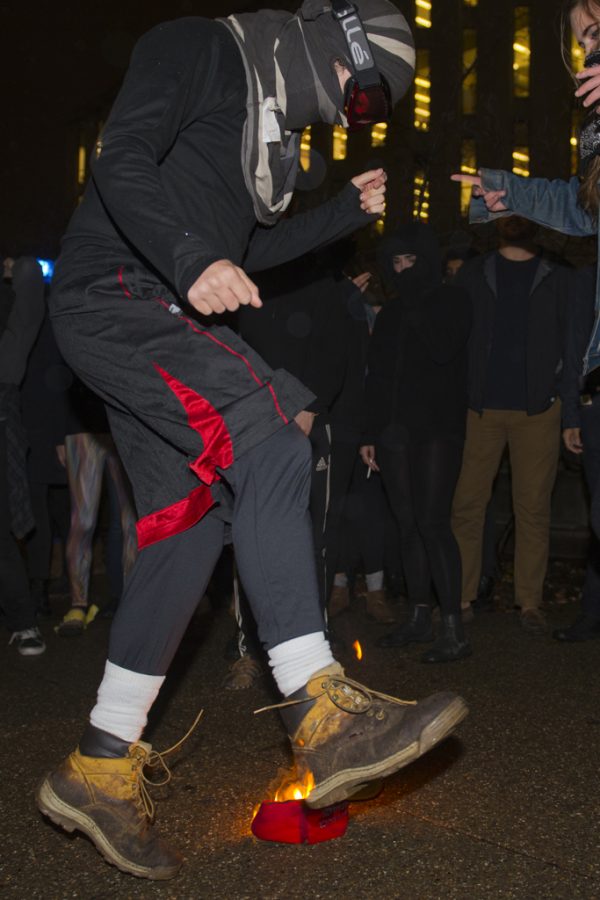Before all final votes could be counted in last week’s election, thousands of people in cities across the country — including Pittsburgh — painted their signs, slipped on their shoes and gathered in the streets to protest.
But as soon as people began protesting Trump’s presidency — and his months of racist, sexist and anti-Islamic language — many of his supporters criticized the protesters for doing so. Now, eight days since election night, the protests continue to dominate the streets of Pittsburgh.
Wednesday night, a group of students and Pittsburghers marched from Oakland to South Side in a peaceful protest, marking the third major event in Pittsburgh since the election last week.
Social media outlets such as Twitter and Facebook blew up in light of the protests, as people denounced the largely young dissenters by calling them “crybabies” — alluding to Rudy Giuliani’s talk on “Fox and Friends” in which he said, “The reality is they’re a bunch of spoiled crybabies.” MSNBC’s Chris Matthews also questioned the protesters motives asking, “What kind of a statement is it really there to make? They lost.”
The outrage echoed by young people who are shocked by the outcome is being dismissed as college students whining and overreacting to Trump’s win, furthering the idea that we are oversensitive millennials who can’t take a loss.
What many pundits and the public fail to realize about the Trump protesters, however, is the exact importance of both the anti-Trump protests, as messages of their own, and as part of a history of protests that have defined and changed this country. Protests have long been the voice of organized movements fighting against institutions of oppression and inequality.
Throughout the ’50s and ’60s, the civil rights movement was characterized by countless protests and boycotts that challenged discriminatory laws toward people of color. The Suffragette movement sparked a protest of well over 5,000 people in the early 1900s, calling for women’s rights to vote. The subsequent days after the Stonewall riots in New York were filled with protests that catapulted the movement for LGBTQ+ rights.
Legislative action is slow — Supreme Court decisions, though they’re meaningful in setting precedent for the future, often follow on the heels of persistent vocalization from social movements.
The publicity of massive protests and movements, and their ability to attract the spotlight, evoke emotional responses and highlight the struggles of marginalized groups, catapults political action.
People understand Trump will be our next president. The protests aren’t refuting that fact or even complaining about the electoral process. The protests are about making it known that the people who have been victimized by Trump’s rhetoric — mimicked by his supporters — are not going to back down easily. Immigrants face the very real fear of deportations, Muslims feel threatened by a proposed ban from this country and members of the LGBTQ+ community are worried that their rights will be stripped away. Furthermore, due to a Republican House, Senate and presidency elected, many groups fear the loss of certain rights and protections they have fought to obtain for years. Trump’s policies have detrimental consequences to our country and people are expressing their fears in unison.
Over the past few months, demonstrations in Cannon Ball, North Dakota, against the Dakota Access Pipeline gained momentum and popularity through social media. In August 2016, members of the Standing Rock Sioux Tribe banded together to prevent construction of a 1,172-mile oil pipeline that would run through sacred land which could potentially damage the reservation’s water source.
People across the world learned about the cause when it gained media attention, and many responded by expressing support and solidarity through social media, petitions and donations.
Interestingly enough, most of these people that are showing support for the Dakota Access Pipeline protesters aren’t directly affected by the construction, yet they have a shared understanding of why the Standing Rock Sioux Tribespeople are protesting. The shared and overwhelming support validates the purpose of the protest, which can lead to legislative action. Although there hasn’t been a formal stopping order on the construction, President Barack Obama allowed for a pause on its construction in order for the U.S. Army Corps to examine possible ways to reroute it.
Unlike the Dakota Access Pipeline protest, the Trump protests don’t seem to have a specific goal, but the unrest makes it known that Trump’s policies will harm millions of people, including laws such as repealing Obamacare, deporting immigrants, banning Muslims from entering the country and overlooking the need for environmental action. The protests are about pressure and vocalization, in an election that where many people felt unheard.
Additionally, the marches instill a sense of unity amongst attendees. When marching with hundreds or thousands of people with a shared sense of outrage, it’s hard to feel vulnerable.
The protests show support for the groups that could be most affected by a Trump presidency and that fear for their own safety.
There have already been numerous reported threats and acts of violence against groups including Muslims, African-Americans and the LGBTQ+ community. Instances such as hijabs being torn off, racial slurs and physical altercations are among the many of the hate crimes marginalized groups face. Trump supporters reportedly assaulted a man in Santa Monica, California, after homophobic words were directed at him.
With thousands of people across the nation with a like-minded attitude, protesting against the president-elect who campaigned on a hate-inducing platform can show that not everybody accepts his attitude.
Though it may be nonsensical to believe that these nationwide protests are going to prevent Trump from being inaugurated in January, perhaps Trump himself will also take notice of what so many Americans find important.
Last week, the president-elect tweeted, “Love the fact that the small groups of protesters last night have passion for our great country. We will all come together and be proud!”
Granted, it’s a slightly condescending acknowledgement, but the Tweet makes it clear that that Trump is aware of the protests.
Whether or not the president-elect will take into consideration why these protests exist is up to the soon-to-be president himself.
Write to Julia Aldrich at [email protected]



